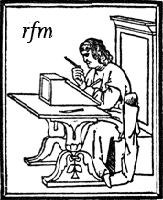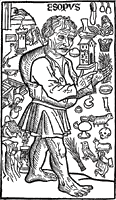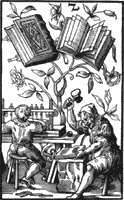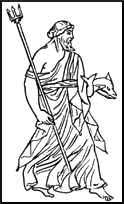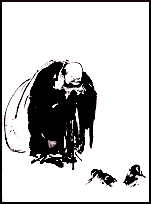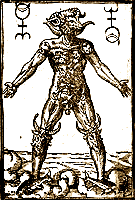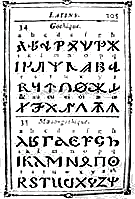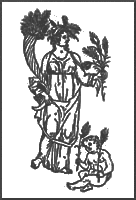Ornamente
Ornamente
Der ganze Mond und der ganze Himmel spiegeln sich im Tau auf dem Gras, sie spiegeln sich in einem einzigen Wassertropfen.
— Dōgen: „Genjō-kōan“
So, wie Dōgen es beschreibt, ist jedes Ding das Ornament seiner Umgebung in genau dieser, seiner ihm eigenen Raum-Zeit — statisch gesehen ein Kreis, ein Mandala, ein Quadrat, ein Schachbrett oder konzentrische Kreise, dynamisch ein aus der Spirale oder ähnlichem entstehendes Ornament, das sich in sich selbst verschlingt und immer wieder zurückzielend auf sich selbst Bezug nimmt. Dieses schöne Ornament allgegenwärtiger Leere ist mit unzähligen Blättern und Knospen — genau jenem Schmuck, den wir ihm hier und jetzt zubilligen, nämlich — bedeckt: Ein jedes Detail verweist auf sich, auf die anderen und das Ganze zugleich.
So gesehen ist das Ornament die einzig gültige Ausdruckweise unserer Existenz, gleich ob es sich um ein gezeichnetes, gemaltes, komponiertes, geschriebenes oder mathematisches handelt: Es beschreibt die Korrelationen zwischen dem Um-uns und ihm bzw. uns selbst — eigentlich jene innerhalb des Kosmos, dessen das Ganze widerspiegelnder Teil wir stets von neuem, in jeder einzelnen Raum-Zeit sind. Jeder Satz, jeder Vers, selbst das, was ich hier grad schreibe, ist solch ein Ornament: Ihre Vielheit wird zum Gewebe, Tantra, dessen Textur das Muster ergibt, durch das wir täglich strömen, das uns in den Wolken des Himmels oder den Blättern des Waldes entgegentönt.
Die Verrätselung der Welt, die wir in Kunst und Literatur vornehmen, ist die Entgegnung auf die radikale Unverständlichkeit des Um-Uns.
Zitate
Laß mich dich unterbrechen. Ja, sie bedeuten, aber sprich es nicht aus, was sie bedeuten: was immer du sagen wolltest, es wäre unrichtig. Sie bedeuten hier nichts als sich selber: Schwäne. Schwäne, aber freilich gesehen mit den Augen der Poesie, die jedes Ding jedesmal zum erstenmal sieht, die jedes Ding mit allen Wundern seines Daseins umgibt: dieses hier mit der Majestät seiner königlichen Flüge; mit der lautlosen Einsamkeit seines strahlenden weißen Leibes, auf schwarzem Wasser trauervoll, verachtungsvoll kreisend; mit der wunderbaren Fabel seiner Sterbestunde . . . Gesehen mit diesen Augen sind die Tiere die eigentlichen Hieroglyphen, sind sie lebendige geheimnisvolle Chiffren, mit denen Gottt unaussprechliche Dinge in die Welt geschrieben hat. Glücklich der Dichter, daß auch er diese göttlichen Chiffren in seine Schrift verweben darf.
Hugo von Hofmannsthal: „Das Gespräch über Gedichte“
Desgleichen erwähne ich jenes an irischen Schmucksachen sowie an skandinavischen Holzschnitzwerken fast in gleicher Weise hervortretende seltsame Prinzip der Ornamentation, das in seinem Schlangengewirre gleichsam urweltlich und finster chaotisch erscheint, in dem Zeitalter Karls des Grossen mit den antiken, d. h. gräkoitalischen ornamentalen Formen in Conflict geräth und sich mit ihnen zu neuen Verbindungen einigt.
Gottfried Semper: „Der Stil in den technischen und tektonischen Künsten“
Now, the way to get the design flat, and at the same time to make it both refined and effective in colour, in a carpet-design, is to follow the second kind of relief I told you of, and to surround all or most of your figure by a line of another tint, and to remember while you are doing it that it is done for this end, and not to make your design look neat and trim. If this is well done, your pieces of colour will look gemlike and beautiful in themselves, your flowers will be due carpet-flowers, and the effect of the whole will be soft and pleasing. But I admit that you will probably have to go to the school of the Eastern designers to attain excellence in the art, as this in its perfection is a speciality of theirs. Now, after all, I am bound to say that when these difficulties are conquered, I, as a Western man and a picture-lover, must still insist on plenty of meaning in your patterns; I must have unmistakable suggestions of gardens and fields, and strange trees, boughs, and tendrils, or I can't do with your pattern, but must take the first piece of nonsense-work a Kurdish shepherd has woven from tradition and memory; all the more, as even in that there will be some hint of past history. (…)
Perhaps a few words on pattern-designing generally may be of some use to some of you, though the chances are you will have heard the same thing said often enough before.
Above all things, avoid vagueness; run any risk of failure rather than involve yourselves in a tangle of poor weak lines that people can't make out. Definite form bounded by firm outline is a necessity for all ornament. If you have any inclination towards that shorthand of picture-painters, which they use when they are in a hurry, and which people call sketching, give up pattern-designing, for you have no turn for it. I repeat, do not be afraid of your design or try to muddle it up so that people can scarce see it; if it is arranged on good lines, and its details are beautiful, you need not fear its looking hard so long as it covers the ground well and is not wrong in colour.
Rational growth is necessary to all patterns, or at least the hint of such growth; and in recurring patterns, at least, the noblest are those where one thing grows visibly and necessarily from another. Take heed in this growth that each member of it be strong and crisp, that the lines do not get thready or flabby or too far from their stock to sprout firmly and vigorously; even where a line ends it should look as if it had plenty of capacity for more growth if so it would.
Again, as to dealing with nature. To take a natural spray of what not and torture it into certain lines, is a hopeless way of designing a pattern. In all good pattern-designs the idea comes first, as in all other designs, e.g., a man says, I will make a pattern which I will mean to give people an idea of a rose-hedge with the sun through it; and he sees it in such and such a way; then, and not till then, he sets to work to draw his flowers, his leaves and thorns, and so forth, and so carries out his idea.
In choosing natural forms be rather shy of certain very obviously decorative ones, e.g., bind-weed, passion-flower, and the poorer forms of ivy, used without the natural copiousness. I should call these trouble-savers, and warn you of them, unless you are going to take an extra amount of trouble over them. We have had them used so cheaply this long while that we are sick of them.
On the other hand, outlandishness is a snare. I have said that it was good and reasonable to ask for obviously natural flowers in embroidery; one might have said the same about all ornamental work, and further, that those natural forms which are at once most familiar and most delightful to us, as well from association as from beauty, are the best for our purpose. The rose, the lily, the tulip, the oak, the vine, and all the herbs and trees that even we cockneys know about, they will serve our turn better than queer, outlandish, upsidedown-looking growths. If we cannot be original with these simple things, we shan't help ourselves out by the uncouth ones.William Morris: “Some Hints on Pattern-Designing”
There is no excellent beauty, that hath not some strangeness in the proportion.
Francis Bacon: “Essays”, “XLIII. Of Beauty”
